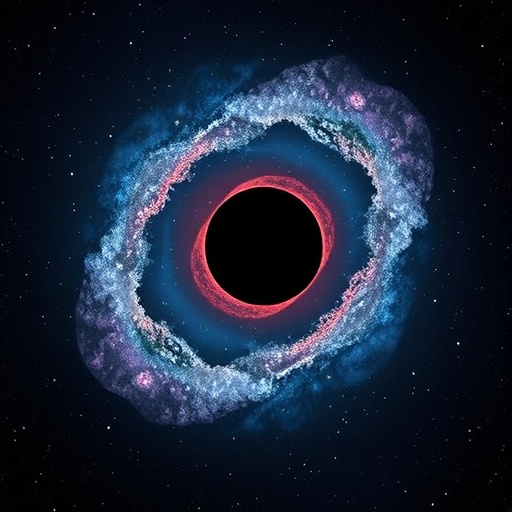Using a global network of advanced telescopes, astronomers have made a groundbreaking discovery: the detection of the lowest-mass dark object known in the universe. This finding could potentially reshape our understanding of dark matter, a mysterious substance that constitutes approximately one-quarter of the universe’s total mass. The results of this significant research were published in two peer-reviewed papers on October 9, 2025, in notable journals: Nature Astronomy and the Monthly Notices of the Royal Astronomical Society.
The newly identified dark object lacks the ability to emit light or any form of radiation, so its presence was established through an intriguing gravitational phenomenon known as gravitational lensing. This effect occurs when an object’s gravity bends and distorts the light travelling near it. By meticulously observing the degree of this distortion, astronomers can deduce the mass of the unseen object that is causing it. This innovative approach has unveiled a new dimension in observational astronomy.
Remarkably, the mass of the newly discovered object is estimated to be around one million times that of our Sun, which is astonishing considering that it was revealed through the methods typically used to detect larger celestial bodies. Scientists believe that it might either be a compact clump of dark matter that is significantly smaller than any previously detected or a small, dormant dwarf galaxy. Both possibilities raise essential questions about the composition and structure of dark matter in the universe.
Dark matter, while invisible and difficult to study directly, plays a pivotal role in shaping the cosmos. It is believed to influence the distribution of galaxies, stars, and other visible structures across the universe. A significant ongoing inquiry in the field of astronomy is whether dark matter can exist in smaller clumps devoid of any stars. Unraveling this mystery is critical to either confirming or refuting current theoretical models regarding dark matter’s nature and behavior.
To achieve this remarkable detection, the research team utilized various sophisticated instruments, including the Green Bank Telescope located in West Virginia, the Very Long Baseline Array in Hawaii, and the European Very Long Baseline Interferometric Network, which consists of radio telescopes scattered across Europe, Asia, South Africa, and Puerto Rico. By integrating data from these telescopes, the team effectively created an Earth-sized super-telescope capable of capturing the subtle gravitational lensing signals produced by the dark object.
The findings highlight the enormous potential of this detection method, as it was able to identify the lowest mass object detected through gravitational lensing by a factor of one hundred. This revelation suggests that applying similar techniques could lead to the discovery of other comparable dark objects scattered throughout the cosmos. The research not only confirms the validity of the cold dark matter theory but also helps to refine our understanding of how galaxies form and evolve in the vast expanse of the universe.
As lead author Devon Powell from the Max Planck Institute for Astrophysics aptly noted, the discovery of one low-mass dark object prompts the pressing question of whether more such entities will be discovered. The results align with existing theories regarding dark matter, igniting curiosity about whether the quantity of detected objects will continue to reflect the predictions of these models.
The research team, which includes co-author Chris Fassnacht, a professor of Physics and Astronomy at the University of California, Davis, is currently undertaking further analysis of their data to delve deeper into the characteristics of this enigmatic dark object. In addition, they are actively searching for more examples of similar dark objects in various areas of the sky.
Overall, the implications of this discovery extend beyond the mere identification of an unseen object. It opens up new avenues of inquiry regarding the nature of dark matter itself and enhances the understanding of the fundamental structures that govern our universe. The question of dark matter’s eccentric existence, particularly in small clumps absent of stars, remains a central issue in cosmology. Determining the nature of dark matter, especially in small sizes, could dramatically impact current theories and enhance our grasp of the cosmos’ architecture.
The research was a collaborative endeavor supported by various prestigious institutions and funding agencies, including the European Research Council, the National Research Foundation of South Africa, and the Italian Ministry of Foreign Affairs and International Cooperation. Such broad collaboration underscores the global commitment to unraveling the mysteries of the universe and advancing the field of astrophysics.
As astronomers sift through the collected data and pursue further observations, the scientific community remains hopeful that this discovery may soon lead to even more groundbreaking findings about dark matter and the universe’s enigmatic composition. The anticipation surrounding the potential future discoveries serves as a testament to the power of collaboration, innovation, and the enduring quest for knowledge in the field of astronomy.
In summary, the detection of the lowest-mass dark object provides a significant breakthrough in astrophysics, with the potential to reshape our understanding of dark matter. As researchers continue to analyze their findings and pursue additional observations, the future holds exciting possibilities for deepening our understanding of the universe and the elusive substance that plays a crucial role in its structure and evolution.
Subject of Research: Dark Matter Detection
Article Title: A million-solar-mass object detected at a cosmological distance using gravitational imaging
News Publication Date: 9-Oct-2025
Web References: Nature Astronomy
References: Monthly Notices of the Royal Astronomical Society
Image Credits: Devon Powell, Max Planck Institute for Astrophysics
Keywords
Dark matter, gravitational lensing, astrophysics, galaxies, cosmic structures, collaboration, observational astronomy.




